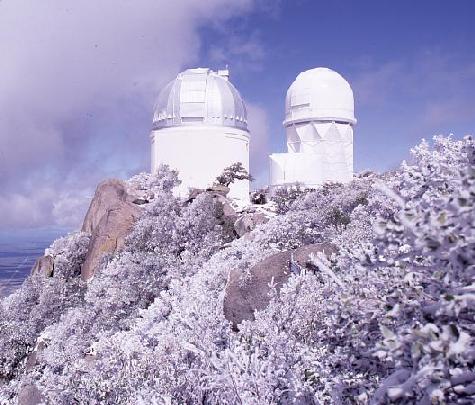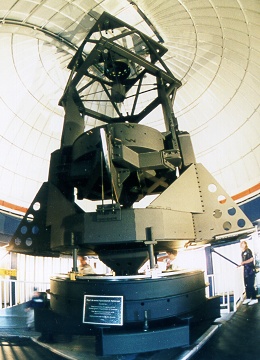Kitt Peak, looking south from atop the 0.9-meter SPACEWATCH® telescope.
Click image to view a 360° panorama! [340k] (Photograph by Mike Read)
SPACEWATCH® currently operates three telescopes on the summit of Kitt Peak.
- 0.9-meter SPACEWATCH® telescope
- 1.8-meter SPACEWATCH® telescope
- 2.3-meter Bok telescope of Steward Observatory (part-time)
SPACEWATCH® 0.9-meter Telescope

Observatory Information
| Geodetic Latitude (Reference Datum WGS 84; +/- 6 meters) | 31.96220° N |
| Longitude (Reference Datum WGS 84; +/- 6 meters) | -111.60038° E |
| Elevation of telescope axes (Reference Datum WGS 84; +/- 10 meters) | 2.08 km |
| IAU Observatory Code | 691 |
| Optical configuration | Old System (to 2002 April) | Mosaic of CCDs (From 2002 Sept) |
| Optics | Newtonian, f/5.34, coma corrected and field flattened | Corrected prime focus, f/3 |
| Filter | Schott OG 515* (See below) | Schott OG-515 |
| Primary mirror diameter | 0.946 m (37.25 inches) | 0.946 m (37.25 inches) |
| Masked mirror diameter | 0.882 m (34.7 inches) | Clear aperture 0.934 m (36.75 inches); secondary shadow 0.3m diameter. Effective collecting area = 0.61 m^2 |
| Image scale (at corrected focus) | 43.8 arcsec/mm | 74.0 arcsec/mm |
| CCD | Tektronix TK2048EB1-1 (2048x2048 pixels), thinned, backside illuminated | Four E2V Technologies Model: CCD42-90-I-941, 4608 x 2048 pixels each, thinned, and backside illuminated |
| Pixel size | 24 microns | 13.5 microns |
| Image scale | 1.05 arcsec/pixel | 1.00 arcsec/pixel |
| Effective field of view | 37' x 33' (RA x Dec) | 2.9 square degrees |
| Exposure time | 2m23s at 0° Dec; 2m38s at +/-25° Dec (drift scanning) | 120 seconds (stare mode) |
| Limiting magnitude | V = 21.5 | V = 21.7 |
* All SPACEWATCH® observations have been and will continue to be made through a Schott OG 515 filter. The filter greatly simplified lens design for the broad (0.5-1.0 micron) bandpass because it allowed us to avoid an atmospheric dispersion compensator, a difficult proposition at these fast f/numbers, and allows us to use flint elements in the lens prescription. It also reduces moonlit sky background.
Log Book of the Steward Observatory's 36-inch Telescope, 1967 June 03- 1986 May 30: Steward Observatory 36-in Telescope Log Book 1967 June 03-1986 May 30 (PDF)
SPACEWATCH® 1.8-meter Telescope

(Photograph by Alain Maury)
Observatory Information
| Geodetic Latitude (Reference Datum WGS 84; +/- 6 meters) | 31.96169° N |
| Longitude (Reference Datum WGS 84; +/- 6 meters) | -111.59995° E |
| Elevation (Reference Datum WGS 84; +/- 10 meters) | 2.08 km |
| IAU Observatory Code | 291 |
Primary mirror: 1.818 meter diameter, f/2.7 paraboloid.
Secondary shadow diameter = 0.78m
Net active optical collecting area = 2..12 m^2
Folded prime focus, coma corrected and field flattened.
Filter: Schott OG 515; see below.
Detector: Fairchild 3041 CCD, 2048 x 2048 pixels, thinned,
backside illuminated, and broad-band antireflection (BBAR) coated.
Pixel size: 15 microns.
Camera: Finger Lakes Instruments ProLine Model PL3041-LC, S/N PL0144010.
Image scale: 0.6 arcsec/pixel.
Field of view: 20 arcmin x 20 arcmin.
Limiting magnitude: R = 22
All SPACEWATCH® observations have been and will continue to be made through a Schott OG 515 filter. The filter greatly simplified lens design for the broad (0.5-1.0 micron) bandpass because it allowed us to avoid an atmospheric dispersion compensator, a difficult proposition at these fast f/numbers, and allows us to use flint elements in the lens prescription. It also reduces moonlit sky background, being a "minus-blue" (i. e., yellow-orange) color.
Instrument History
Download SPACEWATCH® Apparatus Epochs (PDF)
History of SPACEWATCH® 0.9-meter Telescope (PDF)
Carpenters' pics of 0.9m telescope 1920-2012 (PDF)


